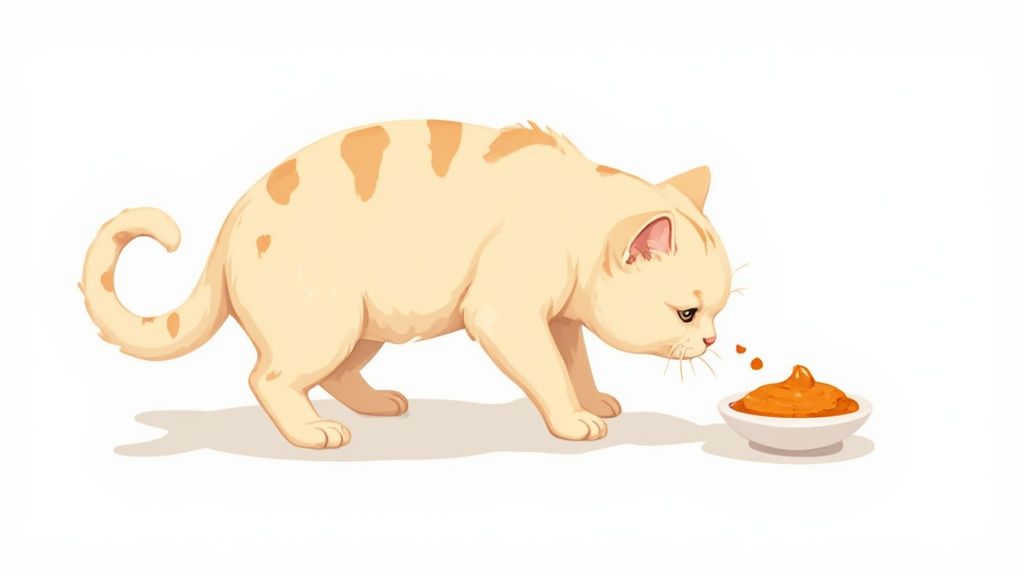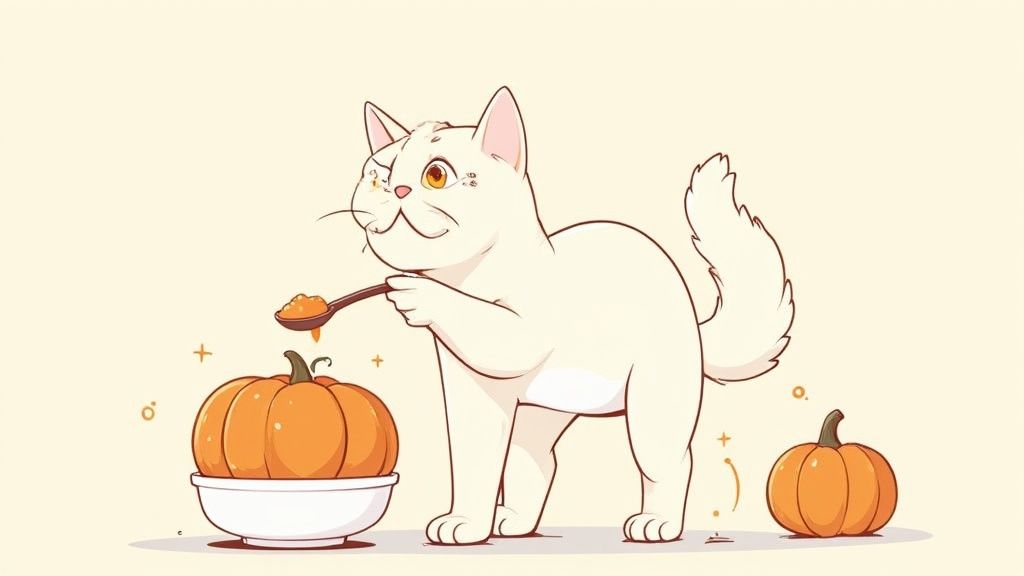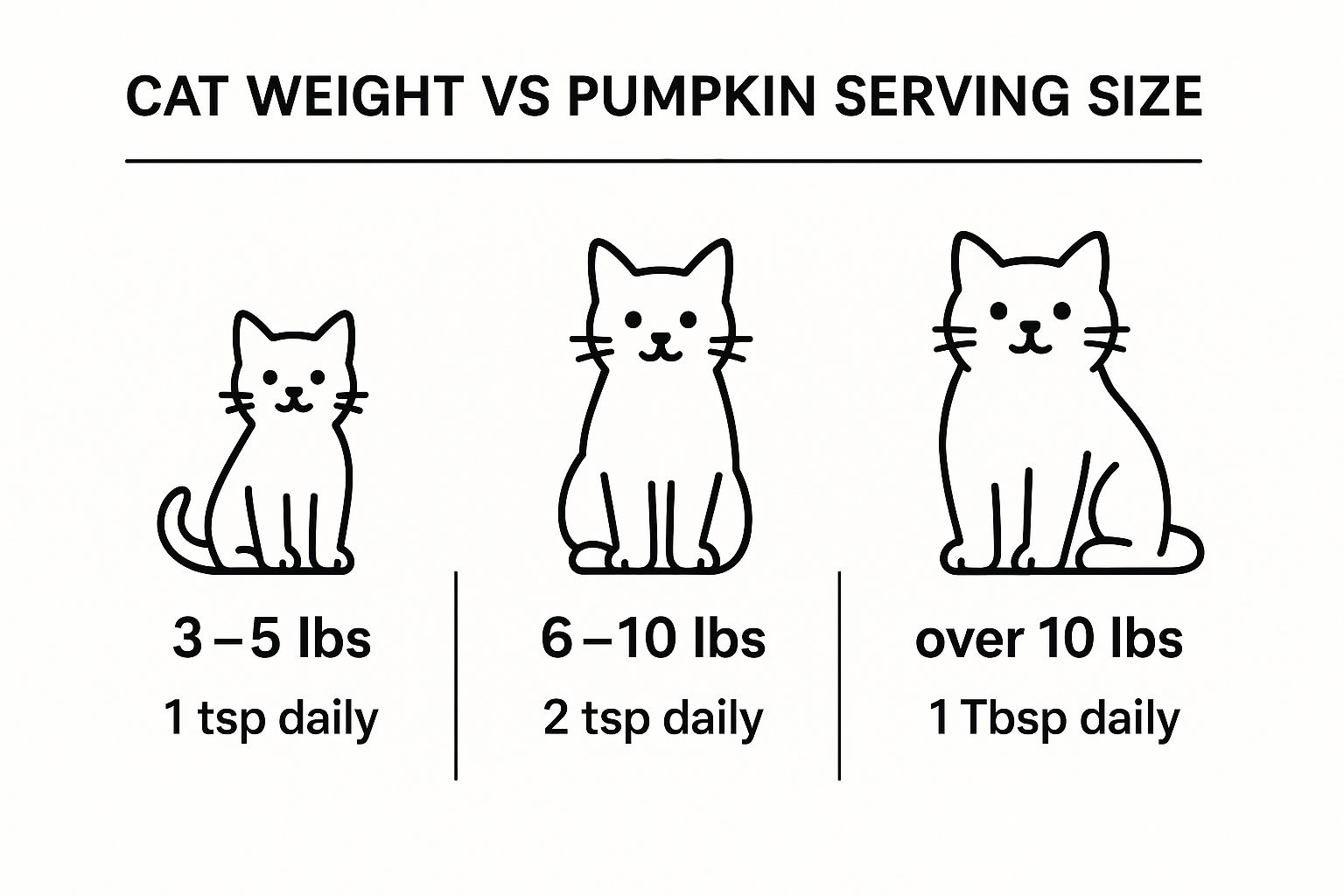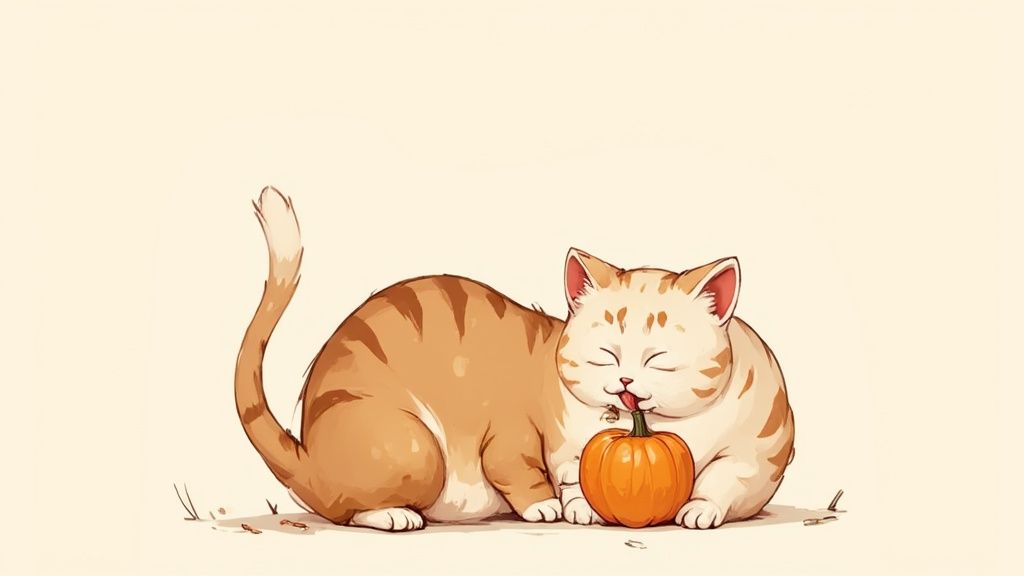Is Pumpkin Good for Cats? A Complete Guide
Published on August 18, 2025
Absolutely, pumpkin can be a fantastic addition to your cat's diet, but only when you know how to serve it correctly. The golden rule is to stick with 100% pure canned pumpkin. Just a small spoonful can work wonders for common digestive woes like constipation or a bout of diarrhea.
What you must never give your cat is pumpkin pie filling. That stuff is loaded with sugar, spices, and other additives that are a big no-no for our feline friends.
The Essential Guide to Pumpkin for Cats
You’ve probably heard people mention pumpkin when talking about cat health, and there's a good reason for that. It’s a simple, natural ingredient that punches well above its weight, acting more like a helpful supplement than a full-blown meal.
Think of it as a gentle, natural regulator for your cat's digestive tract. Thanks to its high fiber and moisture content, it can help soothe an upset tummy, which is why so many cat owners swear by it as a go-to remedy.
But here's the catch: moderation is everything. Too much of a good thing can backfire and cause the very problems you're trying to solve. As a rule of thumb, vets generally advise that pumpkin should make up no more than 10% of your cat's daily calories.
For most adult cats, a great starting point is about one teaspoon mixed right into their regular food. This tiny amount is often all it takes to get things moving smoothly again without causing more upset. For a deeper dive into what makes a balanced diet for cats, you can find excellent resources from trusted pet health experts.
Pumpkin for Cats At a Glance
To make things super simple, I've put together a quick cheat sheet. This little table breaks down the most important things you need to know before you start. It’s the perfect snapshot of the pros, cons, and best practices.
| Aspect | Details |
|---|---|
| Main Benefit | High in both soluble and insoluble fiber, which helps regulate diarrhea and constipation. |
| Key Risk | Giving too much can cause digestive upset. Never use pumpkin pie filling due to harmful additives. |
| Safe Form | Always choose 100% pure canned pumpkin (not the pie mix) or plain, cooked fresh pumpkin. |
| Serving Size | Start with ½ to 1 teaspoon mixed into your cat’s food once or twice a day. |
Think of this table as your starting point. Now that you have the basics down, we can dig a little deeper into exactly how pumpkin works its magic and the best ways to introduce it to your cat.
What Makes Pumpkin a Feline Superfood?

So, what’s the big deal about pumpkin? To really get why it’s so great for cats, we need to pop the hood and look at what it’s made of. This simple squash is way more than just a tasty treat; it’s loaded with good stuff that helps your cat thrive. Its biggest claim to fame is its special blend of fiber.
Think of fiber as the quiet, hardworking hero of your cat’s digestive system. Pumpkin has two different kinds—soluble and insoluble—and each one does a very specific, very important job in keeping your cat's tummy happy. This one-two punch is what makes it such a go-to remedy for pet parents.
The Power of Two Fibers
Imagine your cat's digestive tract is like a busy highway. In this picture, pumpkin's fiber is the expert traffic controller making sure everything flows smoothly and at just the right pace.
- Insoluble Fiber: This is the "bulking" fiber. It doesn't dissolve in water, so it adds weight and substance to your cat's stool. For a constipated kitty, this helps gently push things along and get the traffic moving again. Think of it as the street sweeper clearing the way.
- Soluble Fiber: Now, this type does dissolve in water, creating a gel. If your cat has diarrhea, this gel soaks up all that extra liquid in the gut. This helps firm things up and get their stool back to normal. It’s like a sponge that neatly handles messy situations.
This amazing balancing act is exactly why vets and owners use pumpkin for both constipation and diarrhea. It’s smart enough to adapt to what your cat’s system needs, either hitting the gas or tapping the brakes to restore digestive peace.
By bringing both types of fiber to the table, pumpkin doesn't just put a band-aid on the problem. It actually helps create a stable, healthy gut environment. It’s a natural regulator that works with your cat’s body.
More Than Just Fiber
While fiber usually steals the spotlight, pumpkin is also a treasure trove of essential vitamins and minerals. These micronutrients are critical for supporting all kinds of bodily functions, making pumpkin a fantastic, well-rounded addition to their diet.
For starters, pumpkin is packed with Vitamin A, which is crucial for sharp vision and a robust immune system. It also brings Vitamin C and Vitamin E to the party. These are powerful antioxidants that help protect your cat’s cells from damage while keeping their skin healthy and their coat shiny.
Don't forget the minerals! Pumpkin serves up a nice dose of potassium and iron. Potassium is a must-have for proper muscle and nerve function, while iron is essential for making red blood cells that carry oxygen everywhere it needs to go.
When these nutrients are part of a complete diet, they make a real difference in your cat’s long-term health and energy. You can learn more about how to incorporate such ingredients by checking out some of the best organic cat food brands.
This impressive nutritional profile is why just a spoonful of pumpkin can do so much good. It's low in calories, high in moisture, and delivers a whole lot more than just digestive help.
How Pumpkin Solves Common Digestive Problems

If you peek into the pantry of a seasoned cat owner, you’ll likely find a can of pure pumpkin. There's a good reason for that: it’s an incredible, all-natural tool for handling the most common feline tummy troubles. The magic lies in its unique fiber content, which has a remarkable ability to work in two different ways.
Think of pumpkin as a smart regulator for your cat’s digestive system. Whether things are moving a bit too slowly or way too fast, pumpkin can help bring everything back into balance, offering some much-needed relief for your furry friend.
A Natural Fix for Constipation
When a cat gets constipated, their stool becomes hard, dry, and tough to pass. This is where pumpkin’s blend of insoluble fiber and high water content works wonders. It’s essentially a natural softening agent.
The insoluble fiber adds bulk, which helps get the muscles in the intestinal walls moving. At the same time, the pumpkin—which is nearly 90% water—softens everything up, making it much more comfortable for your cat to go. It’s a gentle nudge, not a harsh laxative.
For a constipated cat, a small spoonful of pumpkin can add just enough bulk and moisture to get their system back on track. It works with their body to encourage a natural, comfortable bowel movement.
The Soothing Solution for Diarrhea
It sounds a little counterintuitive, doesn't it? How can the same food fix two opposite problems? This is where pumpkin’s soluble fiber comes into play. When a cat has diarrhea, there's too much liquid in the colon, making their stool loose and watery.
The soluble fiber in pumpkin acts like a sponge. As it moves through your cat's digestive tract, it soaks up all that excess water, turning into a gel. This firms up loose stools and slows things down, giving your cat’s system a chance to get back to normal. So, is pumpkin good for cats with diarrhea? You bet—it’s one of the best things for it.
This dual-action ability makes pumpkin a must-have for any cat owner.
- For Constipation: It adds moisture and bulk to soften stool.
- For Diarrhea: It absorbs excess water to firm up stool.
It’s this amazing adaptability that makes it such a reliable first choice for minor digestive upsets.
When to Use Pumpkin and When to Call the Vet
Pumpkin is a fantastic home remedy for the occasional digestive issue. A mild case of constipation or a single bout of diarrhea after trying new food are perfect times to mix a teaspoon of pumpkin into your cat's meal.
But it’s important to remember that pumpkin is a supportive supplement, not a cure-all. If the tummy troubles last for more than a day or two, or if you notice other symptoms like lethargy, vomiting, or a loss of appetite, it’s time to call the vet. These could be signs of something more serious that needs a professional diagnosis.
While pumpkin's fiber can help get bowel movements back to normal, it's just one tool in the toolbox. You can find more expert advice on using pumpkin for cat digestive health, including precautions about pumpkin seeds, from trusted veterinary sources at petmd.com.
How to Safely Serve Pumpkin to Your Cat
Knowing pumpkin can help your cat is one thing, but knowing how to serve it is what really counts. Getting this part right is crucial for helping their tummy without accidentally causing new problems.
The secret is to keep it simple. You want pure, unadulterated pumpkin, nothing else. That means becoming a bit of a label detective at the grocery store to understand the huge difference between various pumpkin products.
Choosing the Best Form of Pumpkin
Not all pumpkin is created equal, especially when it comes to our feline friends. What works for our Thanksgiving pie can be a disaster for them. Let’s break down the good, the bad, and the ugly.
Navigating the options can feel tricky, but it's easy once you know what to look for. This table lays out the safest choices and the ones you should steer clear of.
Pumpkin Types: What to Choose and What to Avoid
| Pumpkin Type | Is It Safe? | Key Considerations |
|---|---|---|
| 100% Pure Canned Pumpkin | ✅ Yes (Best Choice) | This is the gold standard. It's just cooked, pureed pumpkin. It’s convenient, has the right consistency, and is free of risky additives. |
| Freshly Cooked Pumpkin | ✅ Yes | A great DIY option. You must bake or steam it until very soft, then remove all seeds, skin, and the stem before mashing it up. |
| Powdered Pumpkin | ✅ Yes (With Caution) | These supplements are a concentrated source of fiber. They're easy to store and measure, but always follow the dosage on the package and check for additives. |
| Pumpkin Pie Filling | ❌ NO (Dangerous) | Never use this. It's packed with sugar and spices like nutmeg, which are toxic to cats. Always double-check the can to be sure. |
| Raw Pumpkin | ❌ NO | Raw pumpkin is tough for cats to digest and can be a serious choking hazard. It must always be cooked. |
The clear winner is 100% pure canned pumpkin. It’s the easiest and safest way to go. Just be absolutely sure it’s not pie filling.
Crucial Warning: I can't stress this enough: Never give your cat pumpkin pie filling. It's loaded with sugar and spices like cinnamon and nutmeg, which can be toxic and lead to serious health problems. Always, always read the label.
How Much Pumpkin to Give Your Cat
When it comes to pumpkin, less is more. You want to start slow and small. Dumping a bunch of fiber into their system all at once can backfire and cause the exact digestive issues you’re trying to fix. Think of it as a small supplement, not a full meal.
For an average adult cat, a great starting point is just half a teaspoon mixed into their food, once or twice a day. If you have a kitten or a very small cat, start with even less—just a quarter teaspoon. This gives their digestive system time to adjust.
Keep an eye on their litter box for the next day or two. If their stool looks better and they seem fine, you can gradually increase the amount if needed. If things get worse, stop the pumpkin and give your vet a call.
This visual guide breaks down the recommended daily amounts based on your cat's weight.

As you can see, the right dose is tied directly to your cat’s size. The goal is always to use the smallest amount that gets the job done.
Potential Risks and Mistakes to Avoid
While pumpkin can be a fantastic addition to your cat's diet, using it the wrong way can turn a helpful remedy into a real problem. Think of it as a powerful tool in your cat care kit—it’s incredibly effective when used right, but you have to know the safety rules. Our goal is to boost your cat’s health, not accidentally create new issues.
The most common mistake people make is surprisingly simple: giving too much. It's so easy to fall into the "if a little is good, more must be better" trap. But with a fiber-rich food like pumpkin, overloading your cat’s system can ironically cause the very digestive upset you’re trying to fix. You could end up with a gassy, bloated, or diarrheic cat.
This is exactly why starting small—just a half teaspoon or so—is the smartest, safest approach. You can always gradually increase the amount if you need to, but you can’t take back the discomfort that comes from giving too much all at once.
The Parts of a Pumpkin to Always Avoid
When we talk about pumpkin for cats, we are only talking about the cooked, pureed flesh. Not every part of the pumpkin is safe for your furry friend to snack on. Some parts are downright dangerous and need to be kept far away from your cat.
Here are the parts you must avoid:
- The Stem: It’s tough, woody, and completely indigestible. It’s a serious choking hazard and can cause a life-threatening internal blockage.
- The Skin or Rind: Just like the stem, the tough outer skin is impossible for a cat to digest. It can also lead to choking or a gastrointestinal obstruction.
- Raw Pulp and Guts: Raw pumpkin is very hard for a cat's stomach to break down and can easily cause digestive upset. It must always be cooked until it’s soft.
While the pumpkin flesh isn't toxic, the physical form and condition of the other parts are what create the risk. Hard pieces like the stem and rind can lead to choking or blockages that require an emergency vet visit. The risk of toxicity also skyrockets if a pumpkin starts to spoil, as explained by the pet safety experts at Texas A&M.
The Danger of Decorative and Spoiled Pumpkins
That festive jack-o'-lantern sitting on your porch might seem innocent, but it can be a serious threat to a curious cat. Carved pumpkins, especially those left out after Halloween, quickly start to decompose, becoming a breeding ground for mold and bacteria.
Some of these molds produce mycotoxins, which are toxic compounds that can cause severe neurological problems if a pet eats them. A cat that nibbles on a rotting decorative pumpkin could suffer from tremors, seizures, or other frightening health issues.
Make sure to throw out old pumpkins right away and keep them well out of your cat's reach. The safest rule of thumb is a simple one: if you wouldn't eat it, your cat shouldn't either.
Your Top Questions About Cats and Pumpkin

So, you’ve got the basics down on why pumpkin can be a great addition to your cat's diet. But I know there are always a few lingering questions that pop up when you're about to try something new.
Let's clear up those common "what ifs" and "how much" questions. Think of this as the final check-in before you start, giving you the confidence to use pumpkin the right way.
Can I Give My Cat Pumpkin Every Day?
Yes, a little bit of pumpkin each day is perfectly fine for most cats. The key is to remember it’s a supplement, not a meal. A great rule of thumb to follow is the “10% rule,” which simply means that treats should never take up more than 10% of your cat’s daily calorie intake.
For an average cat, this works out to about a half or one full teaspoon of pumpkin puree per day. If you’re using it to manage a chronic issue like constipation, it’s always best to chat with your vet to nail down a safe, long-term plan.
Daily pumpkin is generally safe in small amounts, but it can't replace a properly formulated cat food. Your cat's main nutrition must always come from their regular, balanced meals.
What Is the Difference Between Canned Pumpkin and Pumpkin Pie Filling?
This is a huge one, and getting it right is critical for your cat's safety. They often sit right next to each other on the grocery store shelf, but they are completely different products.
- 100% Pure Canned Pumpkin: This is what you want. The ingredients list should have just one thing on it: pumpkin. It's simple, safe, and healthy for your cat.
- Pumpkin Pie Filling: This is a dessert mix, plain and simple. It's packed with sugar and spices like nutmeg and cinnamon, which can be harmful—and even toxic—to cats.
Always, always double-check the label before you buy. You’re looking for the plain, unadorned can of pure pumpkin. Your cat’s health literally depends on it.
Are Pumpkin Seeds Safe for Cats?
This is a bit of a gray area. While finely ground, roasted pumpkin seeds do have some nutritional value, they also come with some serious risks. Whole seeds are a major choking hazard and can easily cause an intestinal blockage.
You should never offer raw, salted, or seasoned seeds. If you’re determined to try them, they have to be thoroughly cleaned, roasted plain (no oil or salt!), and ground into a fine powder to sprinkle over food. Honestly, given the hassle and the potential dangers, just sticking with the puree is a much safer and simpler way to give your cat all the digestive benefits.
Finding the right food is the foundation of your cat's health. At Cat Food Rankings, we make it easy to compare thousands of products by cost, nutrition, and ingredients, so you can make the best choice for your budget and your cat. Find the perfect formula for your feline at https://foodrank.pet/cat.